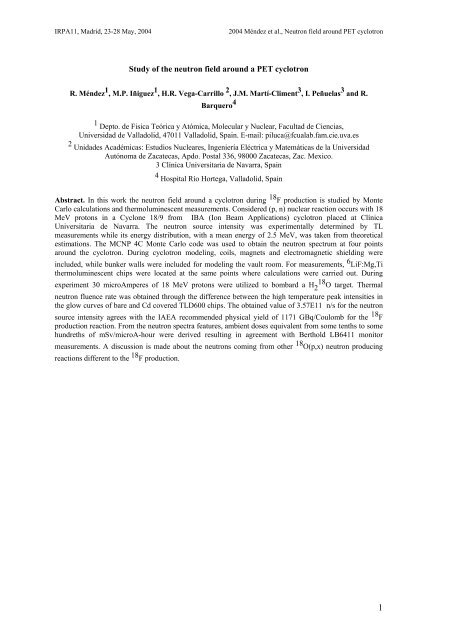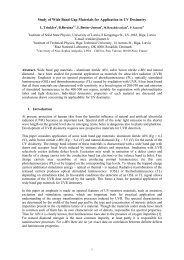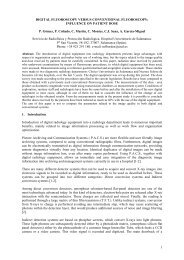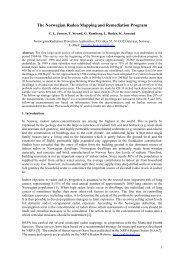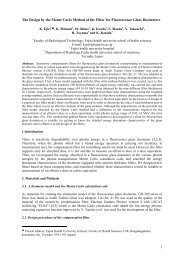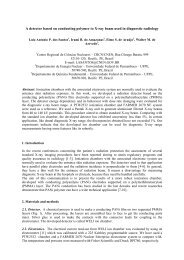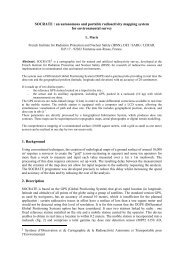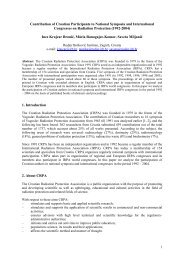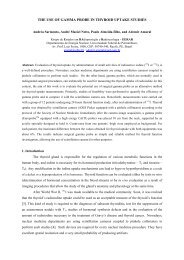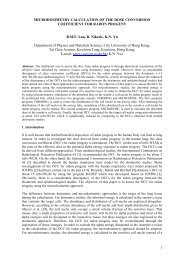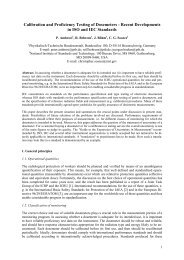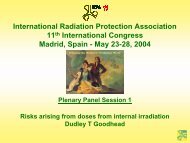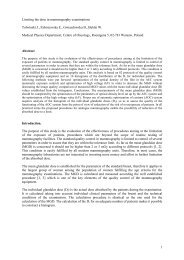Study of the neutron field around a PET cyclotron - IRPA
Study of the neutron field around a PET cyclotron - IRPA
Study of the neutron field around a PET cyclotron - IRPA
You also want an ePaper? Increase the reach of your titles
YUMPU automatically turns print PDFs into web optimized ePapers that Google loves.
<strong>IRPA</strong>11, Madrid, 23-28 May, 2004 2004 Méndez et al., Neutron <strong>field</strong> <strong>around</strong> <strong>PET</strong> <strong>cyclotron</strong><br />
<strong>Study</strong> <strong>of</strong> <strong>the</strong> <strong>neutron</strong> <strong>field</strong> <strong>around</strong> a <strong>PET</strong> <strong>cyclotron</strong><br />
R. Méndez 1 , M.P. Iñiguez 1 , H.R. Vega-Carrillo 2 , J.M. Martí-Climent 3 , I. Peñuelas 3 and R.<br />
Barquero 4<br />
1 Depto. de Fisica Teórica y Atómica, Molecular y Nuclear, Facultad de Ciencias,<br />
Universidad de Valladolid, 47011 Valladolid, Spain. E-mail: piluca@fcualab.fam.cie.uva.es<br />
2 Unidades Académicas: Estudios Nucleares, Ingeniería Eléctrica y Matemáticas de la Universidad<br />
Autónoma de Zacatecas, Apdo. Postal 336, 98000 Zacatecas, Zac. Mexico.<br />
3 Clínica Universitaria de Navarra, Spain<br />
4 Hospital Río Hortega, Valladolid, Spain<br />
Abstract. In this work <strong>the</strong> <strong>neutron</strong> <strong>field</strong> <strong>around</strong> a <strong>cyclotron</strong> during 18 F production is studied by Monte<br />
Carlo calculations and <strong>the</strong>rmoluminescent measurements. Considered (p, n) nuclear reaction occurs with 18<br />
MeV protons in a Cyclone 18/9 from IBA (Ion Beam Applications) <strong>cyclotron</strong> placed at Clínica<br />
Universitaria de Navarra. The <strong>neutron</strong> source intensity was experimentally determined by TL<br />
measurements while its energy distribution, with a mean energy <strong>of</strong> 2.5 MeV, was taken from <strong>the</strong>oretical<br />
estimations. The MCNP 4C Monte Carlo code was used to obtain <strong>the</strong> <strong>neutron</strong> spectrum at four points<br />
<strong>around</strong> <strong>the</strong> <strong>cyclotron</strong>. During <strong>cyclotron</strong> modeling, coils, magnets and electromagnetic shielding were<br />
included, while bunker walls were included for modeling <strong>the</strong> vault room. For measurements, 6 LiF:Mg,Ti<br />
<strong>the</strong>rmoluminescent chips were located at <strong>the</strong> same points where calculations were carried out. During<br />
experiment 30 microAmperes <strong>of</strong> 18 MeV protons were utilized to bombard a H<br />
18<br />
2<br />
O target. Thermal<br />
<strong>neutron</strong> fluence rate was obtained through <strong>the</strong> difference between <strong>the</strong> high temperature peak intensities in<br />
<strong>the</strong> glow curves <strong>of</strong> bare and Cd covered TLD600 chips. The obtained value <strong>of</strong> 3.57E11 n/s for <strong>the</strong> <strong>neutron</strong><br />
source intensity agrees with <strong>the</strong> IAEA recommended physical yield <strong>of</strong> 1171 GBq/Coulomb for <strong>the</strong> 18 F<br />
production reaction. From <strong>the</strong> <strong>neutron</strong> spectra features, ambient doses equivalent from some tenths to some<br />
hundreths <strong>of</strong> mSv/microA-hour were derived resulting in agreement with Berthold LB6411 monitor<br />
measurements. A discussion is made about <strong>the</strong> <strong>neutron</strong>s coming from o<strong>the</strong>r 18 O(p,x) <strong>neutron</strong> producing<br />
reactions different to <strong>the</strong> 18 F production.<br />
1
<strong>IRPA</strong>11, Madrid, 23-28 May, 2004 2004 Méndez et al., Neutron <strong>field</strong> <strong>around</strong> <strong>PET</strong> <strong>cyclotron</strong><br />
1.Introduction<br />
In <strong>neutron</strong> capture <strong>the</strong>rapy <strong>neutron</strong>s are usefull <strong>the</strong>rapeutical particles whose cytotoxicity is caused by a<br />
nuclear reaction between 10 B and <strong>the</strong>rmal <strong>neutron</strong>s. This technique is used in treating brain tumors [1] and<br />
it has been proposed to treat rheumatoid arthritis [2] . In both cases <strong>the</strong> cells to be eliminated are artificially<br />
loaded with a 10 B-enriched compound and subsequently are irradiated with low energy <strong>neutron</strong>s.<br />
By <strong>the</strong> contrary, in o<strong>the</strong>r medical applications <strong>neutron</strong>s arise as undesired products <strong>of</strong> nuclear reactions<br />
occuring inside <strong>the</strong> facility. This is <strong>the</strong> case <strong>of</strong> linear electron accelerators where <strong>neutron</strong>s reach <strong>the</strong><br />
patients [3] and <strong>of</strong> <strong>cyclotron</strong>s for positron emission tomography imaging (<strong>PET</strong>) where <strong>neutron</strong>s constitute a<br />
radiation protection hazard [4 - 6] .<br />
During <strong>the</strong> last years <strong>PET</strong> technique has expanded in several countries where radionuclide imaging has<br />
become a standard method <strong>of</strong> non-invasive exploration. [1] The fluorodeoxyglucose, a <strong>PET</strong> widely use<br />
compound, is labelled with <strong>the</strong> 18 F radioisotope that is formed during <strong>the</strong> 18 O(p, n) 18 F nuclear reaction<br />
where 18 O enriched water is bombarded with 18 MeV protons, producing a <strong>neutron</strong> <strong>field</strong>. [6]<br />
A gamma-ray <strong>field</strong> is also produced during <strong>the</strong> decay and de-excitation <strong>of</strong> nuclides generated along <strong>the</strong> 18 F<br />
producing reactions and from <strong>the</strong> <strong>neutron</strong> induced nuclear reactions with <strong>the</strong> vault room walls and<br />
<strong>cyclotron</strong> materials. This mixed radiation <strong>field</strong> becomes an important issue <strong>of</strong> radiation shielding design. [4,<br />
6]<br />
Neutron <strong>field</strong> features, such as energy and angular distributions, have been experimentaly determined for<br />
proton energies up to 10 MeV. [7] For larger proton energies <strong>the</strong> information required to validate <strong>the</strong><br />
<strong>cyclotron</strong> shielding, to estimate <strong>the</strong> concrete activation and to review <strong>the</strong> radiation protection protocols is<br />
based in <strong>the</strong>oretical cross section data and computer codes.<br />
[5, 8]<br />
A physical yield, expressed in terms <strong>of</strong> activity per electric charge, is defined as <strong>the</strong> ratio between <strong>the</strong><br />
number <strong>of</strong> produced 18 F atoms and <strong>the</strong> amount <strong>of</strong> protons reaching <strong>the</strong> target. The yield increases with <strong>the</strong><br />
beam energy, and for 18 MeV protons its value is 1171 GBq/C. [9] With a half life <strong>of</strong> 110 min <strong>the</strong> 18 F<br />
production rate is 1.115 x 10 10 s -1 -µA -1 producing a strong <strong>neutron</strong> radiation <strong>field</strong> that, inside <strong>the</strong> vault<br />
room and <strong>around</strong> <strong>the</strong> <strong>cyclotron</strong>, means large <strong>neutron</strong> doses. Mostly <strong>of</strong> <strong>the</strong> <strong>neutron</strong> <strong>field</strong>s encountered in<br />
radiation protection practice have a broad energy distribution, knowledge <strong>of</strong> <strong>the</strong> <strong>neutron</strong> spectrum is<br />
necessary for assessing <strong>the</strong> radiation protection conditions <strong>around</strong> <strong>the</strong>se facilities. [10]<br />
In this investigation <strong>the</strong> <strong>neutron</strong> spectra were simulated at four locations inside <strong>the</strong> vault room <strong>of</strong> a <strong>PET</strong><br />
<strong>cyclotron</strong> by means <strong>of</strong> Monte Carlo methods. Concerned <strong>neutron</strong>s are mainly produced by evaporation<br />
during <strong>the</strong> 18 O(p, n) 18 F nuclear reaction having a peak close to 2 MeV. These emitted <strong>neutron</strong>s interact<br />
with <strong>the</strong> <strong>cyclotron</strong> materials and <strong>the</strong> vault room walls producing <strong>neutron</strong> spectra whose features depend<br />
upon <strong>the</strong> site, being harder close to <strong>the</strong> target and s<strong>of</strong>ter as <strong>the</strong> site is away <strong>the</strong> target . The <strong>the</strong>rmal portion<br />
<strong>of</strong> <strong>the</strong> spectrum was measured with LiF:Mg,Ti dosemeters, and from <strong>the</strong>se measurements <strong>the</strong> source<br />
intensity was obtained, after comparisson with <strong>the</strong> simulated spectra.<br />
2.Materials and Methods<br />
Facility description<br />
The <strong>cyclotron</strong> is a negative ion accelerator made by Ion Beam Application Radioisotopes model Cyclone<br />
18/9 located at <strong>the</strong> Navarra University Hospital. It is housed in a 480 x 400 x 363-cm 3 vault room shielded<br />
by concrete walls <strong>of</strong> up 200 cm thick. [5, 6] The <strong>cyclotron</strong> is operated during some minutes at a proton<br />
beam current <strong>of</strong> 30 µA for <strong>the</strong> TLD's irradiations.<br />
Thermoluminescence<br />
Ribbon type <strong>the</strong>rmoluminescent LiF:Mg,Ti dosemeters 0.3 x 0.3 x 0.1 cm 3 from Harshaw were used. They<br />
were covered with a Cd foil to determine <strong>the</strong> <strong>the</strong>rmal <strong>neutron</strong> fluence rates at four sites inside <strong>the</strong> vault<br />
room. Those are labelled A, B, C and D, and are at 100, 100, 176 and 50 cm from <strong>the</strong> <strong>cyclotron</strong> surface,<br />
and with an orientation relative to <strong>the</strong> target: at 90º, 180º, 0º and 0º. TLD600 contains 95.6% <strong>of</strong> 6 Li that<br />
allows to detect <strong>the</strong>rmal <strong>neutron</strong>s while TLD700 has 99.9% <strong>of</strong> 7 Li that is insensitive to <strong>the</strong>rmal <strong>neutron</strong>s.<br />
The two TLD's have <strong>the</strong> same response to gamma rays <strong>of</strong> not as much energy as to produce photonuclear<br />
2
<strong>IRPA</strong>11, Madrid, 23-28 May, 2004 2004 Méndez et al., Neutron <strong>field</strong> <strong>around</strong> <strong>PET</strong> <strong>cyclotron</strong><br />
reactions. [11] These, were calibrated in <strong>the</strong> <strong>neutron</strong> <strong>field</strong> produced by a water-moderated 1.11 x 10 11 Bq<br />
AmBe source. During <strong>the</strong> TLDs reading <strong>the</strong>y were preheated to 100 o C and heated up to 350 o C at a rate <strong>of</strong><br />
10 o C/s. The area under <strong>the</strong> high temperature peak (~ 270 o C) <strong>of</strong> <strong>the</strong> glow curves was used to determine <strong>the</strong><br />
<strong>neutron</strong> fluence rate. During <strong>the</strong>rmal <strong>neutron</strong> irradiations TLDs were located in small methacrylate boxes,<br />
one covered with <strong>the</strong> Cd foil and o<strong>the</strong>r without it.<br />
Simulations<br />
Neutron spectra and <strong>neutron</strong> doses were calculated at <strong>the</strong> four sites above mentioned. Vault room and<br />
<strong>cyclotron</strong> were modeled and <strong>neutron</strong>s transported using <strong>the</strong> Monte Carlo code MCNP 4C. [12] The "Des",<br />
Cu coils, iron magnets and electromagnetic shielding were explicitly included. Because its complexity<br />
details about <strong>the</strong> target were omitted, instead a point-like source was located at 1 cm-depth in <strong>the</strong> <strong>cyclotron</strong><br />
upper section. The source term was taken form Carroll [8] that is similar to an evaporation model given by,<br />
Q(E) = 0.59 E 0.45 Exp[ - E/2.7] (1)<br />
here, E is <strong>the</strong> <strong>neutron</strong> energy in MeV. In Fig. 1 <strong>the</strong> evaporation and Carroll´s models are shown toge<strong>the</strong>r.<br />
Figure 1. Initial spectrum in <strong>the</strong> simulations<br />
The number <strong>of</strong> histories utilized during calculations was 10 6 , this was large enough to have uncertainties<br />
less than 1% in <strong>the</strong> integral parameters and less than 3% in <strong>the</strong> <strong>neutron</strong> spectra energy bins.<br />
Remmeter<br />
An active probe Berthold LB6411 with a 3He <strong>the</strong>rmal detector inside a 25 cm diameter polyethylene sphere<br />
was utilized.<br />
3.Results and discussion<br />
The area under <strong>the</strong> high temperature peak in <strong>the</strong> glow curve <strong>of</strong> TLD600 contains <strong>the</strong> information <strong>of</strong> any<br />
energy <strong>neutron</strong>s, while <strong>the</strong> respective area under Cd-covered TLD600 only contains information about<br />
<strong>neutron</strong>s whose energy is larger than approximately 0.4 eV. From <strong>the</strong> difference <strong>of</strong> bare and Cd-cover high<br />
3
<strong>IRPA</strong>11, Madrid, 23-28 May, 2004 2004 Méndez et al., Neutron <strong>field</strong> <strong>around</strong> <strong>PET</strong> <strong>cyclotron</strong><br />
temperature area peak <strong>the</strong> <strong>the</strong>rmal <strong>neutron</strong> fluence rate, E < 0.4 eV, can be obtained, after calibration <strong>of</strong> <strong>the</strong><br />
TLD’s in <strong>the</strong> moderated AmBe source. Resulting values are shown in Table 1.<br />
Site Bare TLD600<br />
coulombs<br />
Cd covered TLD600<br />
coulombs<br />
A 1404 277<br />
B 997 188<br />
C 3270 763<br />
D 4070 1433<br />
Table 1. TLD readings and corresponding <strong>the</strong>rmal <strong>neutron</strong> fluences.<br />
Thermal <strong>neutron</strong> Fluence<br />
n cm -2 s -1<br />
7.13 . 10 5<br />
5.12 . 10 5<br />
1.59 . 10 6<br />
1.67 . 10 6<br />
On <strong>the</strong> o<strong>the</strong>r hand, <strong>the</strong> simulated <strong>the</strong>rmal <strong>neutron</strong> fluence rates for a unitary source, C th , are given in Table<br />
2. Also is given <strong>the</strong> percentual contribution <strong>of</strong> <strong>the</strong>rmal <strong>neutron</strong>s % respect to <strong>the</strong> total energy range.<br />
Site C th n cm -2 s -1<br />
A 2.55 . 10 -6<br />
B 1.84 . 10 -6<br />
C 3.98 . 10 -6<br />
D 3.52 . 10 -6<br />
%<br />
36.1<br />
45.9<br />
16.0<br />
4.12<br />
Table 2. Simulated unitary <strong>the</strong>rmal fluences.<br />
From it one sees that <strong>the</strong> proportion <strong>of</strong> low energy <strong>the</strong>rmal <strong>neutron</strong>s varies strongly with <strong>the</strong> distance to <strong>the</strong><br />
target. The <strong>neutron</strong> production strength was derived by averaging <strong>the</strong> results at <strong>the</strong> four points.<br />
From <strong>the</strong> comparisson between Tables 1 and 2 a source intensity can be derived, which after being<br />
averaged for <strong>the</strong> four considered points results in a value <strong>of</strong> 3.57. 10 11 n/s. Taking into account <strong>the</strong> proton<br />
courrent used <strong>of</strong> 30 µA, <strong>the</strong> corresponding IAEA recomended value would be 3.345. 10 11 n/s which is very<br />
similar. Resulting <strong>neutron</strong> dose rates are in good agreement with <strong>the</strong> Berthold LB6411 readings which are<br />
21, 7 and 210 mSv/µA h at sites A, B and C, respectively, and out <strong>of</strong> range at site D.<br />
4.Final conclusions<br />
The <strong>neutron</strong> fluence rate <strong>around</strong> a <strong>PET</strong> <strong>cyclotron</strong>, DURING 18 F PRODUCTION, has been determined through<br />
Monte Carlo calculations and <strong>the</strong>rmoluminescence measurements.<br />
An agreement between <strong>the</strong> obtained <strong>neutron</strong> intensity at <strong>the</strong> target and <strong>the</strong> IAEA recommended value was<br />
found from <strong>the</strong> <strong>the</strong>rmal <strong>neutron</strong> fluence measurements along with <strong>the</strong> spectrum simulations. If initial<br />
energy spectrum and o<strong>the</strong>r ingredients assumed in <strong>the</strong> simulations are accurate enough, that agreement<br />
reveals that <strong>neutron</strong>s coming from o<strong>the</strong>r nuclear reactions different from just that producing 18 F could be<br />
neglected. An experimental measurement <strong>of</strong> <strong>the</strong> <strong>neutron</strong> spectrum is in progress.<br />
Acknowledgements<br />
Authors thanks <strong>the</strong> colaboration with Universidad de Cantabria, Universidad Politécnica and CIEMAT,<br />
Madrid, and <strong>the</strong> Hospital Arturo Eyries <strong>of</strong> Valladolid.<br />
5.References<br />
1. Cerullo, N., Daquino, G.G., Muzi, L. and Esposito, J. Development <strong>of</strong> a treatment planning system<br />
for BNCT based on positron emission tomographydata: preliminar results. Nuclear Instruments and<br />
Methods in Physics Research B 213(1) (2004): 637-640.<br />
2. Vega-Carrillo, H.R. and Manzanares-Acuña, E. Neutron source design for boron <strong>neutron</strong> caputre<br />
synovectomy. Alasbimn Journal 6(22), (2003): 1-9.<br />
3. Barquero, R., Méndez, R., Iñiguez, M.P:, Vega-Carrillo, H.R. and Voytchev, M.<br />
Thermoluminescence measurements <strong>of</strong> <strong>neutron</strong> dose <strong>around</strong> a medical linac. Radiation Protection<br />
4
<strong>IRPA</strong>11, Madrid, 23-28 May, 2004 2004 Méndez et al., Neutron <strong>field</strong> <strong>around</strong> <strong>PET</strong> <strong>cyclotron</strong><br />
Dosimetry 101(1-4), (2002): 493-496.<br />
4. Vega-Carrillo, H.R.. Neutron energy spectra inside a <strong>PET</strong> <strong>cyclotron</strong> vault room. Nucl. Instrum.<br />
Meth. Phys. Res. A 463 (2001): 375-386.<br />
5. Martí-Climent, J.M., Peñuelas, I. and Richter, J.A. Radiation protection in a clinical <strong>PET</strong> center.<br />
Eur. J. Nucl. Med. 23 (1996) 1245.<br />
6. Martí-Climent J.M., Méndez, R., Peñuelas, I., Iñiguez, M.P., Serra, P., Barquero, R., Vega-<br />
Carrillo, H.R. Neutron dosimetry <strong>around</strong> a <strong>cyclotron</strong> during positron emission radionuclide production. J<br />
Nucl Med 44(5), (2003): 327p-328p<br />
7. Carroll, L.R. Estimating <strong>the</strong> radiation source term for <strong>PET</strong> isotope targets. Ninth International<br />
Workshop on Targetry and Target Chemistry. Turku Finland (2002)<br />
8. Carroll, L.R.. Predicting long-lived induced activation <strong>of</strong> concrete in a <strong>cyclotron</strong> vault. AIP<br />
Conference Proccedings 576(1), (2001): 301-304.<br />
9. IAEA. Charged particle cross-section database for medical radioisotope production: Diagnostic<br />
radioisotopes and monitor reactions. International Atomic Energy Agency Technical document 1211.<br />
(2001)<br />
10. ICRU. Determination <strong>of</strong> operational dose equivalent quantities for <strong>neutron</strong>s, International<br />
Commision on Radiation Units and Measurements Report 66, Journal <strong>of</strong> <strong>the</strong> ICRU 1(3), (2001): 27-33.<br />
11. Méndez, R., Iñiguez, M.P., Barquero, R., Mañanes, A., Gallego, E., Lorente, A. and Voytchev, M.<br />
Response components <strong>of</strong> LiF:Mg,Ti <strong>around</strong> a moderated Am-Be <strong>neutron</strong> source, Radiation Protection<br />
Dosimetry 98(2), (2002): 173-178.<br />
12. Briesmeister, J.F. (editor) MCNP TM -A general Monte Carlo N-particle transport code. Los<br />
Alamos National Laboratory report LA13709-M, (2000).<br />
5


